One of the major commuter routes from Philadelphia to the northern suburbs, the Fort Washington Expressway, has its beginnings in 1947. It was in that year that the Philadelphia City Planning Commission drew up plans for an expressway, referred to as the North Penn Expressway, from Montgomery County to the northeastern section of the city and the Tacony Expressway from there to Interstate 95. Construction began in 1956 on the first segment of the expressway between the Pennsylvania Turnpike and Bethlehem Pike, just north of Spring House. As work continued on that part, construction began on the section between the Ogontz Avenue/Easton Road intersection and the Pennsylvania Turnpike in 1958. The final year of the 1950s would see the expressway open between the PA 73 interchange and Bethlehem Pike.
The remainder of the Fort Washington Expressway between the Easton Road interchange, which was built to be an elaborate connection to the eventually-cancelled Ten-Mile Loop Expressway, and the PA 73 interchange opened to traffic in 1960. After completion, the US 309 designation was removed from Stenton Avenue between Ogontz Avenue and East Willow Grove Avenue, that street, Germantown Avenue, and Bethlehem Pike. The Department of Highways had applied to the American Association of State Highway Officials to move the designation the year before the roadway opened entirely due to three "severe" turns that would be eliminated, but more so due to the completion of the expressway. Much like most of the original Pennsylvania Turnpike was built on the former South Penn Railroad right-of-way, this expressway was built on a former Pennsylvania Railroad right-of-way. Just as many expressways were constructed at the time, the Fort Washington Expressway suffers from short acceleration and deceleration lanes, a lack of shoulders, and a narrow median.
As time took its toll on the expressway, the Pennsylvania Department of Transportation announced in 1998 a $160 million project to rehabilitate the entire Fort Washington Expressway. The project consisted of six contracts, four for the expressway and two for work involving nearby roadways, and was divided into three sections: South Section (Cheltenham Avenue to PA 73), Central Section (PA 73 to Highland Avenue), and North Section (Highland Avenue to PA 63). Work entailed reconstructing the concrete pavement between Cheltenham Avenue and PA 63; repairing or replacing 36 bridges, culverts, and overpasses; building a new Fort Washington Interchange at the Turnpike; building a new PA 152/Easton Road interchange; lengthen 16 other on and off-ramps at seven additional interchanges; improving the intersection at PA 63; widening the expressway's shoulders to 12 feet and the median to eight feet; installing sound walls at several locations; installing a 50-inch-high concrete median barrier/glare screen; improving storm water drainage; installing cameras, variable message signs, and other Intelligent Transportation System (ITS) components; and improving intersections and roadways close to the expressway. The sound walls were a point of contention, because this was not a new highway nor a major reconstruction project, PennDOT would not fund them from its federal transportation allotment, and therefore did not include them in the designs. US Representative Joseph Hoeffel and former Representative Jon Fox were able to obtain two grants totaling $9 million in federal funding, earmarked for this purpose under the 1998 Federal Transportation Equity Act for the 21st Century (TEA-21). The Commonwealth was then required to match the funding and contributed $2.25 million.
An official groundbreaking ceremony was held November 9, 2002, at the Fort Washington/Pennsylvania Turnpike interchange, which is the geographic center of the work zone. At the end of the ceremony, State Transportation Secretary Bradley L. Mallory was joined by elected officials from Montgomery County to toss the symbolic first shovel-fulls of dirt to signify the start of construction.
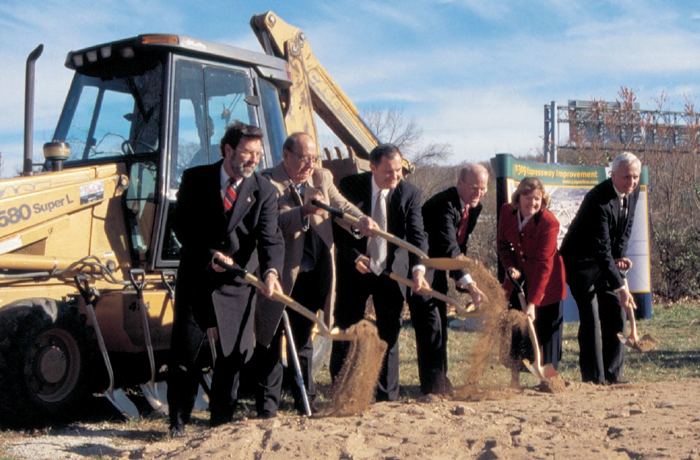 |
| From left to right: state Representative Eugene McGill, state Representative Edwin Holl, State Transportation Secretary Bradley L. Mallory, US Representative Joesph M. Hoeffel, state Represenative Kate Harper, and state Senator Stewart Greenleaf (Pennsylvania Department of Transportation) |
The first phase of the project was the improvement of 32 intersections and sections of roadway adjacent to the Fort Washington Expressway involving mostly Bethlehem Pike, PA 152/Limeklin Pike, and PA 73/Church Road. PennDOT took a proactive approach to enhance traffic flow on these roadways by adding turning lanes, widening existing pavement, and installing new traffic signals in preparation for when work would begin on PA 309 as drivers would more than likely use them to bypass the construction zone. Work on those off-site roadways began in early 2001 and finished in mid-2002. The second phase of advance construction finished in late 2003 when the new overpasses for Summit Avenue and the Pennsylvania Turnpike opened. A longer one was needed in the latter case because part of the work involving the Fort Washington/Pennsylvania Turnpike interchange consisted of reconnecting the two sections of Pennsylvania Avenue which were severed when the expressway was built. Plus, the new bridges would comply with modern minimum clearance requirements for expressway overpasses. On Bethlehem Pike, reconstruction of the bridge over SEPTA's R5 Regional Rail Line began in October 2003 and was completed in summer 2004. The first part of this work involved construction of a new roadway connecting Bethlehem Pike, Morris Road, and Lafayette Avenue which opened in October 2003.
PennDOT began rehabilitation of the expressway on the central section, except for the area of the Pennsylvania Turnpike interchange, between PA 73 and Highland Avenue in Upper Dublin Township, in early 2004. In addition to the roadway reconstruction, the $57.9 million contract included six expressway bridges and two overpass being rehabilitated, one at Madison Avenue and the other at Fort Washington Avenue, were replaced. The ramps at the PA 73 interchange were lengthened. Contractors finished rebuilding the expressway from PA 73 to just south of the Fort Washington interchange and north from there through the Highland Avenue interchange in 2006. Sound walls were also installed along much of the roadway between PA 73 and Fort Washington, and rebuilt bridges carrying Fort Washington Avenue and Madison Avenue opened to traffic that year as well.
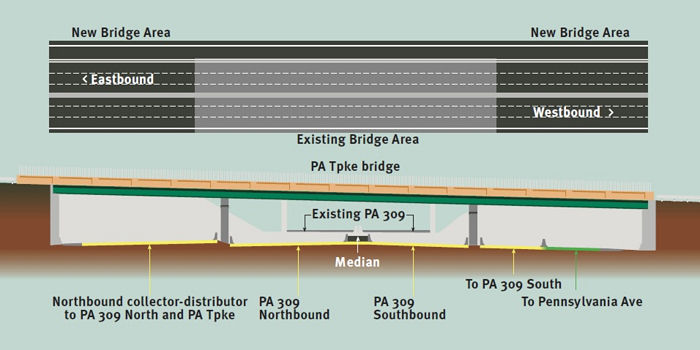 |
| Cross-section of the Fort Washington Expressway at the Fort Washington/Pennsylvania Turnpike interchange showing its final configuration. (Pennsylvania Department of Transportation) |
The $82.6 million contract to reconstruct the Fort Washington/Pennsylvania Turnpike interchange began in January 2005, which would include construction of a collector/distributor lane to separate northbound through traffic from traffic heading to the Turnpike and Pennsylvania Avenue. Pennsylvania Avenue was extended as a two-lane roadway through the new interchange for direct access between Oreland and Fort Washington without traffic having to use PA 309. A new fly-over ramp was constructed to provide southbound drivers with direct access to the Turnpike and Pennsylvania Avenue, replacing a loop ramp that was removed to provide room for the Pennsylvania Avenue extension. Construction of a temporary railroad overpass at the southern end of the interchange, parallel to the existing bridge, began as well. By the middle of 2005, most of the structural pieces of the new fly-over ramp were in place, and the new northbound ramp to the Turnpike was largely in place. Also by that time, preliminary work was underway on the new alignment of Pennsylvania Avenue through the interchange and the temporary railroad bridge was nearing completion.
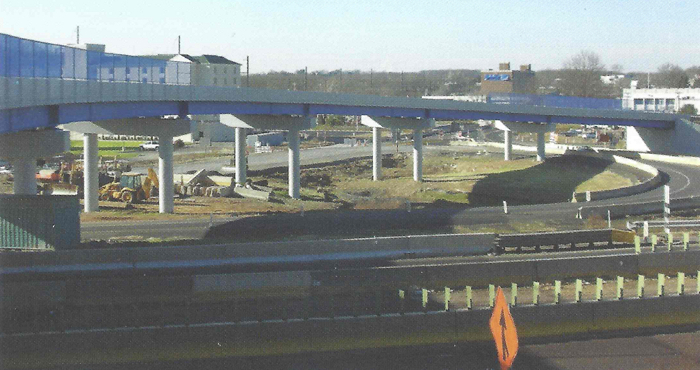 |
| The flyover ramp built to facilitate southbound traffic heading to the Pennsylvania Turnpike. (Pennsylvania Department of Transportation) |
A lot of work had been accomplished at the Fort Washington/Pennsylvania Turnpike interchange by 2006. The new fly-over ramp for southbound traffic to access the Pennsylvania Turnpike opened in May. On the opposite side of the interchange, the new northbound ramp to the Turnpike opened, while crews began building the northbound collector/distributor lane which would run through the interchange. Widening of the northbound PA 309 bridge over the ramp to the Turnpike and Commerce Drive continued. Numerous components of the storm water management system were installed in 2006. The old railroad overpass at the southern end of the interchange was demolished as crews began building a new, permanent bridge to carry the railroad. Just south of there, the former Oreland off-ramp was permanently closed to allow construction of the new section of Pennsylvania Avenue.
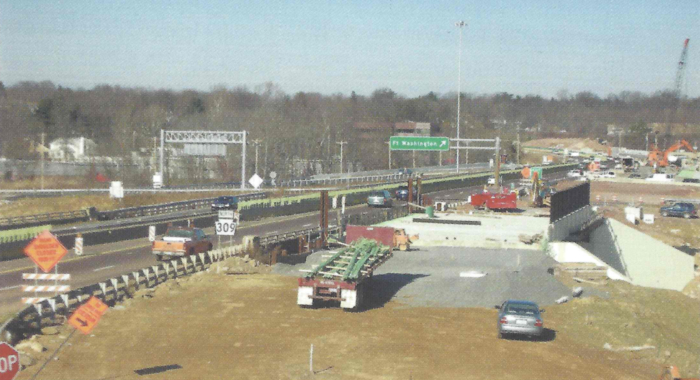 |
| Construction taking place on the future collector/distributor lane at the Fort Washington/Pennsylvania Turnpike interchange. (Pennsylvania Department of Transportation) |
Reconstruction of the northbound side of PA 309 through this interchange, and the new northbound collector/distributor lane at this interchange, were both completed in 2007. Traffic was shifted onto the new northbound lanes mid-year, while southbound traffic was moved to the middle of the expressway. Reconstruction of the southbound lanes through the interchange, as well as the bridges over Commerce Drive, Pennsylvania Avenue, and SEPTA's R5 Regional Rail Line began. After completion of the new Norfolk Southern Railroad bridge, Nyleve Bridge Corporation followed industry practice and sold the perfectly good working 467-foot-long structure that had temporarily carried the railroad across the expressway to Versa Steel Inc., of Portland, Oregon. The bridge is currently located in Rhode Island.
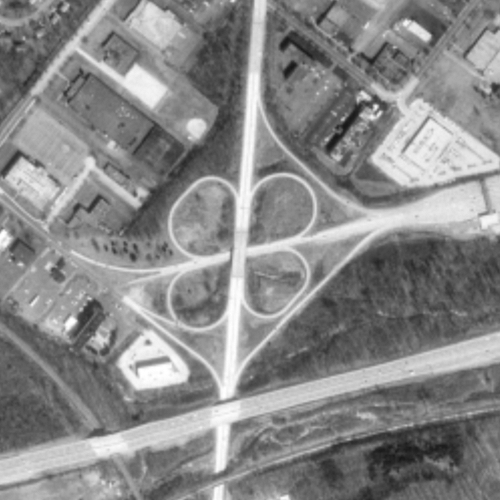 |
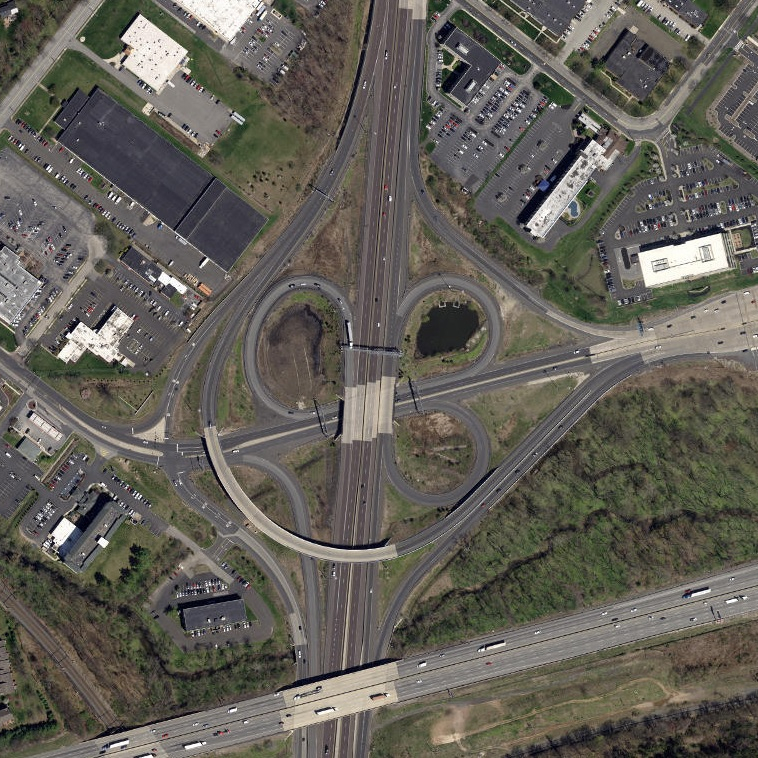 |
| Aerial pictures of the Fort Washington/Pennsylvania Turnpike interchange before (left) and after (right) reconstruction. (Pennsylvania Spatial Data Access) | |
Reconstruction on the southern section began May 2, 2005, from Cheltenham Avenue to PA 73. Upon the announcement of the start, PennDOT District Executive Andrew L. Warren said, "We are continuing to move forward with this needed program to rebuild and improve this 50-year-old expressway so it can move traffic safely and smoothly in the 21st Century." Work entailed reconstructing the expressway, rehabilitating three bridges and one overpass, sound wall installation, reconfiguring the PA 152/Easton Road interchange into a diamond interchange, and lengthening the ramps at the Paper Mill Road interchange. All of that, including new traffic signals installed at the end of the ramps, and a pedestrian underpass was built between Springfield High School and Springfield Middle School under the expressway were part of the $88.3 million contract.
There was very little evidence remaining of what the previous PA 152/Easton Road interchange looked like by the middle of 2005. The old roadway, ramps, and structures had been demolished as earth moving began to establish grades for the new interchange. Northbound widening and reconstruction were mostly completed in the work zones north and south of the Turnpike interchange, with construction shifting to the southbound side. Crews finished improvements to the southbound side from Fort Washington/Pennsylvania Turnpike interchange to south of the PA 73 interchange, then moved in early 2006 to the center third of the roadway. Work also shifted to the southbound side from the Fort Washington interchange north to Highland Avenue, where retaining wall construction began. Western abutment construction began at Madison Avenue and Fort Washington Avenue, as did widening of the PA 309 bridges over Highland Avenue, Camp Hill Road, and PA 73, while construction continued on the northern half of the Valley Green Road overpass. Northbound widening and reconstruction began in late summer 2005 between the PA 152/Easton Road and Paper Mill Road interchanges.
At the PA 152/Easton Road interchange, the reconstructed mainline lanes were opened to traffic by the end of 2006. The new Easton Road overpass was built, and Easton Road was partially widened on both sides of the interchange. Traffic was shifted onto the new Easton Road alignment and bridge in July 2006, with widening then beginning on the opposite side. South of this interchange, widening and improvements were completed on the northbound side of PA 309/Ogontz Avenue at Cheltenham Avenue, Shopper's Lane, and Greenwood Avenue. Widening also progressed on the northbound side of the expressway north of Easton Road through the Paper Mill Road interchange. Retaining walls were built to support the widening on both sides of the Willow Grove Avenue overpass, and the northbound structures over Paper Mill Road, Haws Avenue, and Waverly Road were widened as well. The new Valley Green Road overpass was finished in 2006, as was the southern half of the Willow Grove Avenue bridge over the expressway. Replacement wetlands were created adjacent to the northbound lanes near Camp Hill Road.
The new on and off-ramps at the PA 152/Easton Road interchange opened to traffic in 2007. Widening work on Easton Road concluded late in the year, along with improvements that added turn lanes at intersections and rebuilt PA 309/Ogontz Avenue from Cheltenham Avenue to Easton Road. Between Easton Road and Paper Mill Road, reconstruction wrapped up on the northbound side, while the southbound lanes were finished to the south of the Willow Grove Avenue overpass, which itself was also completed late in the year.
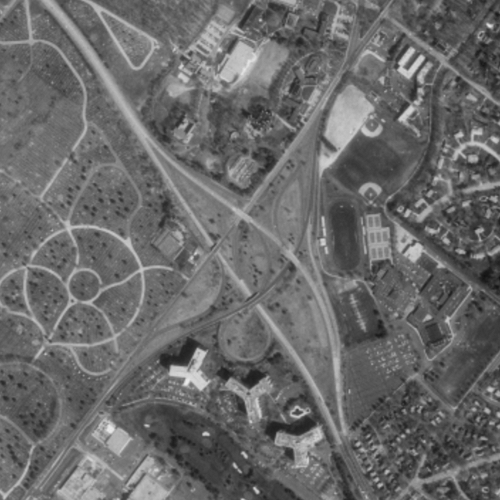 |
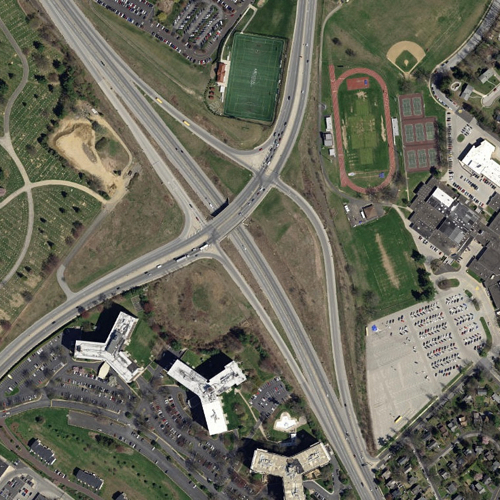 |
| Aerial pictures of the PA 152/Easton Road interchange before (left) and after (right) reconstruction. (Pennsylvania Spatial Data Access) | |
Reconstruction began on the final section, the northern section, on July 5, 2007. Rebuilding the shoulder on the southbound side of the expressway, removing the median, and traffic was shifted to the southbound side while reconstruction began on the northbound side were the first things to be done. The Cedar Hill Road overpass was removed, while the northbound bridge over Bethlehem Pike was demolished and construction continued on the southbound one. Ramps at the Susquehanna Road, Norristown Road, and Butler Pike interchanges were lengthened, and sound walls were constructed on the southbound side of the expressway between the latter two interchanges. Part of the work also involved widening Bethlehem Pike from the end of the expressway, where the northbound ramp to Bethlehem Pike was widened to two lanes, to the PA 63/Welsh Road intersection. The $102.48 million contract wrapped up in July 2011, which signaled the end of the entire $375 million project. PennDOT paid 20% of the cost, while the Federal Highway Administration picked up the remaining 80%.
During inspections of completed bridge decks in the project area in December 2011, hairline cracks were discovered. It was determined that the cracks did not pose any issues to the structural integrity, and PennDOT sealed the affected decks to prevent water from infiltrating the concrete and lessening the lifespan of those bridges.
 Fort Washington Expressway
Fort Washington Expressway INFORMATION
INFORMATION